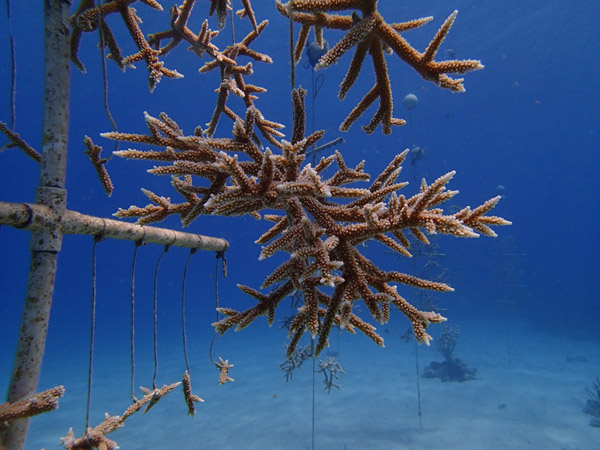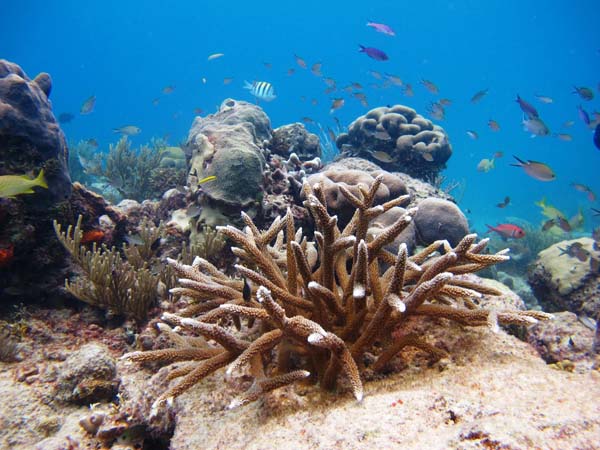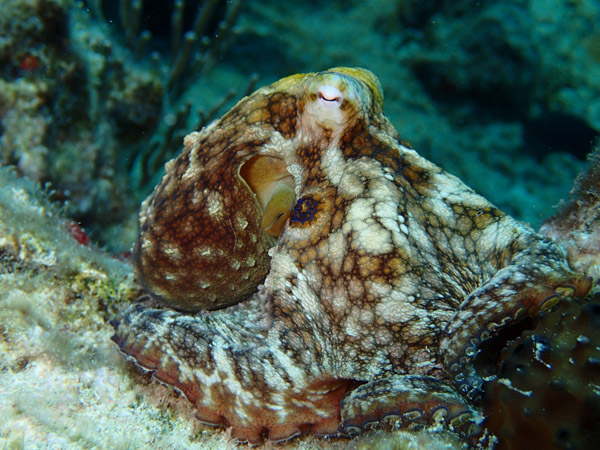An octopus that steals coral? Dolphin volunteers? Welcome to the unexpected side of coral reef restoration.
I have been working to restore coral reefs in the US Virgin Islands, and the wider Caribbean for more than four years now and what I observe during these adventures never ceases to amuse and entertain me.
The Nature Conservancy’s process for coral restoration is straightforward: We rescue pieces of threatened elkhorn and staghorn corals that have naturally broken off and would otherwise die if left unattended.
As these two coral species are the foundation of coral reefs in the Caribbean, it’s critical that we assist in their recovery—to bring back a reef system that by some estimates has been depleted by as much as 80 percent.
Those rescued corals are maintained within underwater coral nurseries, which are tended similar to gardens. Some of our nurseries are filled with structures made from cinderblocks that are anchored to the seafloor by rebar and covered by PVC sleeves to ease the cleaning effort.
Other nurseries are filled with PVC “trees” upon which corals are hung, similar to a Christmas tree. After a year, corals are multiplied within nurseries or transplanted to local reefs using a non-toxic two-part epoxy.

We occasionally have community volunteers come visit our coral restoration projects and help support various activities needed to maintain the nurseries.
We’ve also received help from a number of surprising characters!
One curious volunteer we had a while back was a bottlenose dolphin that was hanging out with us during a coral nursery maintenance dive.
When I revisited the nursery a few days later, I noticed that the PVC sleeves had been removed from the rebar anchors and were scattered on the sea floor.
I observed this again after a few subsequent dives and believe that the dolphin tried to help us out (I guess we could have spent more time demonstrating how to replace the PVC sleeves onto the rebar anchors!).
We also received help from parrotfishes as well as blue tangs, doctorfish, and surgeonfish that eat the algae growing on our coral nursery structures.
These are extremely helpful volunteers, given that we need to remove algae that compete against coral for space. In fact, we now situate our nursery structures close enough to healthy reefs so that these coral reef-dwelling herbivores can readily remove algae on our behalf.
Our latest volunteer recently stumbled into one of our staghorn restoration plots at Cane Bay on St. Croix. This little common octopus tried to take one of our recently transplanted staghorn corals for his own.
The epoxy had not yet hardened and we struggled to rescue our staghorn coral colony from this sneaky “klepto-octopus.”
When it was clear that we would win the battle for the coral, the octopus still thought he could get away with just the epoxy. But, we won that battle also.
See for yourself in the video below. Although I’m underwater, you can clearly hear my reaction.
And every time that I replay this video, I am reminded that I have a pretty awesome job.
Dolphins and octopus are among the most intelligent marine organisms in our oceans and both have provided great experiences within our coral nurseries and our restoration sites.
What will visit next? Who knows, but I am definitely looking forward to our next unique “volunteer.”





Hello Kemit-Amon!
By doing some research on coral conservation in the Caribbean, I can say I am very excited by the work you lead in the U.S.V.I.
I am a recent college graduate and will be moving to St. Thomas in May to follow my dreams of island living and marine conservation, specially coral reef restoration. I would love to get in contact with you about being apart of your team to help save our oceans. If you can reply your email or if this is easier here is mine: hvbaillargeon3420@eagle.fgcu.edu
Best,
Helen
I feel your efforts at ‘saving’ a coral reef are misguided. Less belief in human science, and more faith in the whole incalculable wisdom of the Earth, more humility, would be a good thing. Humans ‘steal’, not other creatures such as Octopi. Nor are other creatures of the sea your “volunteers.” Nor is it y o u r coral, regardless you set up a nursery of coral fragments. Perhaps the Bottlenose Dolphin was telling you to abandon your project?
This is not a laughing matter.
Conservation means leaving well enough alone. Stop trying to manipulate Nature. Seek the source of the problem, and put your efforts towards changing that.
Wow. This is a first. Never heard anyone say that we should avoid trying to fix the damage that humans have helped cause. Especially a project like this that is taking soon to be dead animals and providing them the habitat they need to continue living and reproducing. It’s sort of like saying to get rid of all hospitals because if you need one you should just die…. Somehow I don’t think the Universe is with you on this one. Wow.
Gwynn,
We do what we do.. and I personally do what I do because a lot of the problems on Earth (and at sea) were caused by man. My personal philosophy is that it is only fitting that we try to fix some of the problems that we (I use this loosely) have caused. We have already seen, with sea turtle populations, that you can proactively remove or reduce the man-made threats towards building the resilience of natural populations and that those populations will begin to recover. We are doing the same now with corals and I am very happy with our results so far. Trust me, I don’t do what I do for amusement; no – it is not a laughing matter. The work that we are focused on to restore and recover Caribbean coral populations is ongoing because there is no alternative. Coral reefs are too important for marine organisms and for people to allow their continued degradation. Reefs are not just marine habitat, they also provide food, tourism and recreation activities, shoreline protection, and provide for historical and modern cultural and medicinal uses. To that end, we will continue to do all that we can to protect and restore this natural resource.
It’s a decorator octopus! Why should crabs have all the fun? Great video. Thanks for sharing.
I think the octopus activity will also build the reef and
you are a jerk to interfere.
That post is really fun and cute. Do you think the Octopus after the epoxy? or the Coral…I wonder if it just looks like a good item to block the entrance to its cave.
Hello Kemit-Amon,
My name is Alexa and I really enjoyed this post I saw on Facebook. I currently I live Thailand and have been here since January of this year. Ive been told from locals here that this is an above average hot summer. I’ve been diving here for the last four months and haven’t noticed any coral bleaching until the other day. It’s actually quite sad honestly but that topic is for another day. I work with a dive shop here in Pattaya Thailand and have been asked to look up/research different methods of coral restoration projects and see if this could be possible to start here. I’ve contacted people here in Thailand, I’ve read some online things and I’ve reached out some old professors I had from university. All gave me good ideas but I couldn’t not to the opportunity to ask someone who is in field this very moment. I was wondering if you could give me a quick overview of what you are doing, the materials used, pictures, any conclusion or better yet if you have a paper or papers I could read that would be beneficial. I know you are probably very busy but I can’t wait to hear back from you. The ocean is my life and I have studied it and now just becoming an instructor I hope I can teach people not only scuba diving but more about conversation and as scuba divers what we can do to help. I truly appreciate you taking the time to read my comment and hope to hear from you.
Happy bubbles!!
Alexa Rosenberger
Hi Alexa,
It’s always good to hear when dive operators become proactive about marine resource conservation – that’s very admirable. Please email me directly at klewis@tnc.org and I’ll forward our guide to Acropora coral restoration. The guide is a good review of our best practices for coral nursery and restoration activities and also has case studies from others actively conducting coral restoration throughout the Caribbean. That should be a good start and I can also answer questions as they arise.
All the best,
Kemit
Stop diving, would be a good start.
Is diving really the problem? How about overfishing, fishing with chemicals/dynamite, ships dragging anchors, industrial runoff, climate change, etc. Divers are generally more aware of what is changing underwater, and seek to help preserve the habitat. As to your other comments about conservation, I think we are trying to preserve what is left of the earth for the benefit of our species and the few others as well that get the most press (polar bears, whales, etc). If we do nothing, the earth will rid itself of us sooner rather than later.